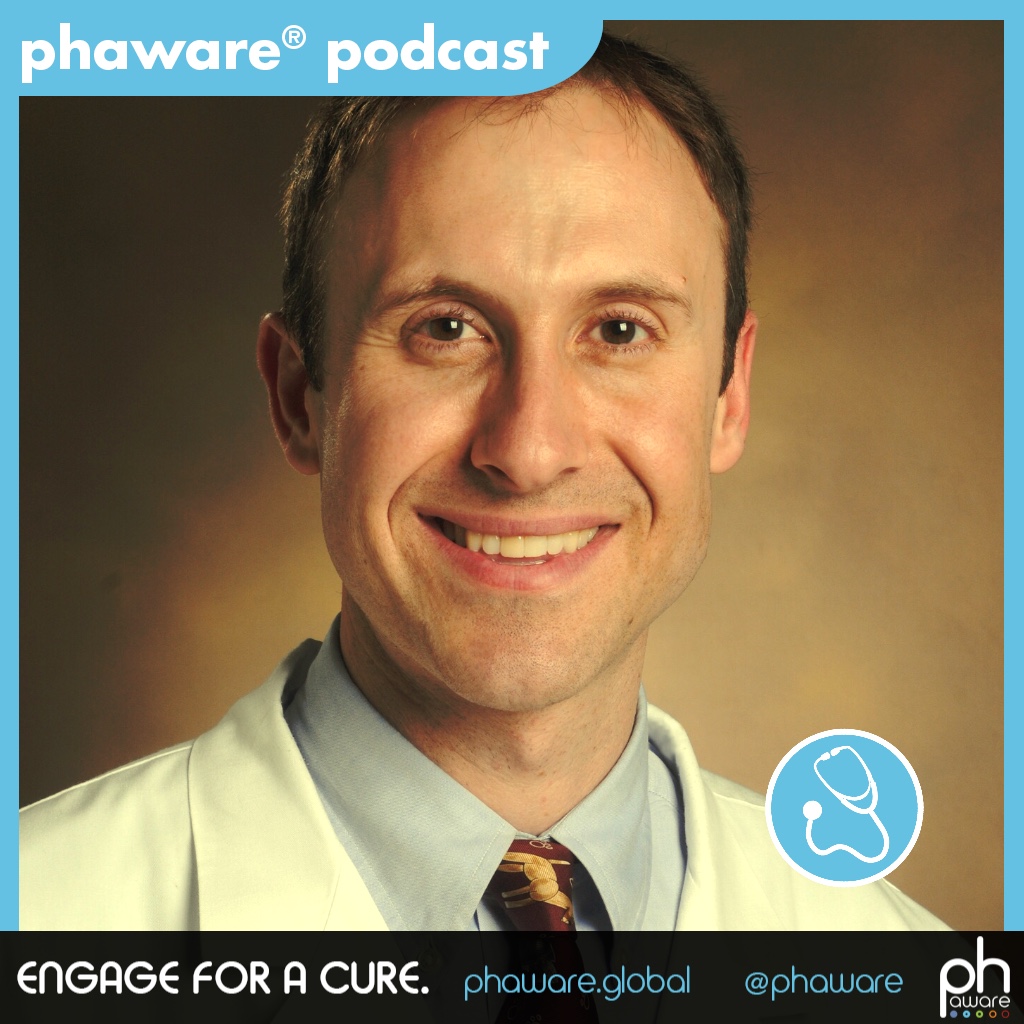Phaware Podcast: Eric Austin, MD, MSCI (Part 1 of 3)

This podcast series, created and produced by phaware, is being offered as a regular guest feature on Pulmonary Hypertension News to bring the voices and life experiences of PH patients, family members, caregivers, healthcare specialists, and others to our readers. You may listen to the podcast directly, or read it via the transcript that runs below.
I’m Aware That I’m Rare: Eric Austin, MD MSCI
The phaware® interview (Episode 116)
Eric Austin is the Director of the Vanderbilt Pediatric Pulmonary Hypertension (PH) Program at Vanderbilt University Medical Center’s Monroe Carell Jr. Children’s Hospital, where he treats individuals with pulmonary hypertension and other pulmonary vascular diseases. He is also a member of the adult program’s Vanderbilt Pulmonary Hypertension Clinical and Research Program, with whom he leads and/or participates in various translational research studies.
Hello. I’m Eric Austin. I’m the director of the Pulmonary Vascular Disease Program at the Vanderbilt Children’s Hospital here in Nashville, Tennessee.
Today, I’d like to talk to you a little about screening for pulmonary hypertension among those who would be at risk of the disease but don’t know that they have it.
One of the things when we think about pulmonary hypertension is the notion that there are people who have the disease that are being treated all over the world for this challenging condition. However, there are also a group of people who are at risk of developing pulmonary hypertension but do not currently have the disease.
The concept of thinking about screening for detecting disease early on is very exciting and would suggest that we may have an opportunity to intervene earlier with therapies to perhaps one day either prevent the onset of the disease or at least to dull its impact on the person and delay its impact on them over time.
The concept of screening really invokes the notion of what we call secondary prevention, that is, to detect the disease in its earliest stages before those symptoms actually appear. The goal would be to intervene and slow or stop the disease progression, as I already mentioned, and it really gets at the key underlying hope and assumption that earlier detection and intervention of disease is actually going to be beneficial. We believe that to be true in pulmonary hypertension and in pulmonary vascular disease more broadly, but I must admit we don’t have tremendous clinical trial or other data to support that at this time.
Nonetheless, one of our major goals in the program here at Vanderbilt is to detect people earlier before they have clinically manifest disease so that we could help them to be healthier longer in their lives. When I think about prevention versus treatment, one easy analogy would be to think of the individual trying to deal with a hose and water flying out of that hose. If water’s already flying out of that hose, it’s really hard to stop it without a massive, strong kink in the hose that takes a lot of effort and may not work, similar to therapeutic approaches for people who are already under care for a condition.
Another way to think about it, if you never let the cat out of the bag, you never have to try and put the cat back in it. It’s really important in my mind to try and find ways to prevent the disease from ever being expressed in a person, and that would make it a whole lot easier than if we had to then go and treat disease. In pulmonary hypertension, this is particularly relevant, because we know that your degree of pulmonary vascular disease and involvement of the pulmonary blood vessels probably has a lot to do with when you’re diagnosed.
There’s some early information on humans, although not robust data, that’s been generated throughout the years. It suggests that you could lose upwards of 70 percent of your pulmonary vasculature in terms of its functioning correctly before you develop pulmonary hypertension. What that suggests to us is that once people are diagnosed with pulmonary hypertension, they probably have profound disease throughout their pulmonary blood vessels that is causing their pulmonary hypertension. At that point, really, a lot of the damage has already been done, and whether we could really truly reverse that damage is unlikely. What we try and do at that point is to help people cope and prevent further progression of damage.
If we could get to a point where we could diagnose people earlier in the spectrum of pulmonary vascular disease, perhaps when they still have 70 percent of their blood vessels working correctly, perhaps we could either prevent it from ever happening or really, really delay the progression of disease into pulmonary hypertension.
What we’re basically trying to do with screening is to shift the axis so that we diagnose people earlier. Now, diagnosis of pulmonary hypertension by screening methods is actually challenging for a number of reasons. One of which is that, thankfully, pulmonary hypertension is a fairly rare disease in the population. You’re probably not going to screen every single person in the world for pulmonary hypertension using some agreed-upon modality, because that just would not make sense. The vast majority of individuals throughout the world will never develop pulmonary hypertension in their lifetime, thankfully. You’re talking about a low prevalence disease. It’s not going to benefit from a high impact of application across all populations.
What you want to do is target high-risk individuals most likely to develop the disease, so then we could actually really make an impact on those people with highest risk. What could you do to screen people to determine whether they have developed pulmonary hypertension or not?
There are a few different ways you could think about it. You could think about it, number one, using a noninvasive study that would be ideal so that we don’t have to have people undergo sedation or undergo really incredibly challenging circumstances just to get a diagnosis. Number two would be some sort of noninvasive measure of how do they function. Number three would be a more invasive measure of their pulmonary vasculature.
Let’s talk about those real quick. What if you think about a noninvasive study? Really, the options there are largely built around blood testing. Somewhat invasive, truly, but as you know, a blood prick is thankfully not a major deal for most individuals.
Types of noninvasive studies would include genetic testing. We could think about testing for the most common rare variations or mutations in our DNA of our body that associate with pulmonary hypertension; those include genes such as BMPR2 gene, ALK1 gene, endoglin gene, EIF2AK4 gene, TBX4 gene, and some others. One could look for mutations to be present in people who may or may not know they have risks. Those mutations are so rare, it probably makes the most sense to look for those mutations in people who have a known risk of disease already, based upon maybe some sort of familial condition in other members of the family that is not present in the person you’re worried about right now.
Another way to think about it would be this blood or urine to look for chemical markers like NT-proBNP or BNP, more broadly. You could look for those metrics, thinking, well, if the BNP or the NT-BNP are abnormal, that might suggest my heart is under some degree of stress. Those are quite non-specific and probably not ideal for screening at this time. I hope to one day get to a point where we deal with “-omic” studies. We’re thinking about genomics, proteomics, what are the proteins in your blood, what are the genes in your blood, what are the metabolism features or metabolomics, and integrating all these different arrays of data to come up with a risk profile that might best identify those people who will develop disease.
We do not currently have that, but there are many groups around the country and around the world working on this idea, that we could integrate a personal blood element profile that would be highly suggestive of someone who will one day develop pulmonary hypertension that could one day also be used to then track therapeutic response over time.
What about noninvasive measures of “function?” The obvious ones would be the electrocardiogram. It would measure what does your heart look like in a moment in time from an electrical conduction perspective and will give suggestions about how the heart is doing. Maybe it’s under stress, which could suggest right ventricular stress, which could suggest pulmonary hypertension.
Or more commonly these days, actually, would be a view of the heart using an ultrasound such as an echocardiogram, which can give a lot of information about the heart during the moment of time during the study. More fancy noninvasive measures of function include cardiac MRI to look at the heart, PET-CT for thinking about imaging, including metabolic imaging techniques such as FDG-PET. There’s emerging data around more experimental studies that might give us some information, but many of these are quite expensive, so the echocardiogram and the electrocardiogram are usually the best place to start.
Finally, there’s invasive measures of pulmonary hypertension assessment for pulmonary vascular disease assessment. This would include the cardiac catheterization, either a right or a complete cardiac catheterization, with or without pulmonary angiography. Then even more invasive measures such as a lung biopsy and a right ventricular biopsy.
Let’s be realistic about what would be the most likely things in the current era that we’re using to evaluate people at risk and determine if they have pulmonary hypertension before they actually clinically express disease or “feel bad.”
I hope you’ve understood from today’s discussion that screening for pulmonary hypertension is incredibly important and can be very valuable to help us diagnose people earlier in their trajectory of pulmonary vascular disease and hopefully improve their long-term outcome. Our goal is to provide prevention of the expression of the disease, ever. That may not be possible, but at least we could hopefully dampen or make less severe the pulmonary hypertension if and when it ever presents. When we think specifically about pediatric cases, there’s really a lack of pediatric data to dictate how and when to screen for most conditions.
My name is Eric Austin and I’m aware that I’m rare.
EVERYBODY HAS A STORY. WHAT’S YOURS?
Phaware global association wants to share your pulmonary hypertension story with their engaged global audience. Whether you are a patient, caregiver, or medical professional, they are enlisting PH community members from around the world.
Visit www.phawarepodcast.libsyn.com/contact to share your story and to be considered for a future episode. Never miss an episode with the phaware® podcast app. Learn more about pulmonary hypertension at www.phaware.global. #phaware
Note: Pulmonary Hypertension News is strictly a news and information website about the disease. It does not provide medical advice, diagnosis, or treatment. This content is not intended to be a substitute for professional medical advice, diagnosis, or treatment. Always seek the advice of your physician or other qualified health provider with any questions you may have regarding a medical condition. Never disregard professional medical advice or delay in seeking it because of something you have read on this website. The opinions expressed in this column are not those of Pulmonary Hypertension News or its parent company, Bionews Services, and are intended to spark discussion about issues pertaining to pulmonary hypertension.










Leave a comment
Fill in the required fields to post. Your email address will not be published.